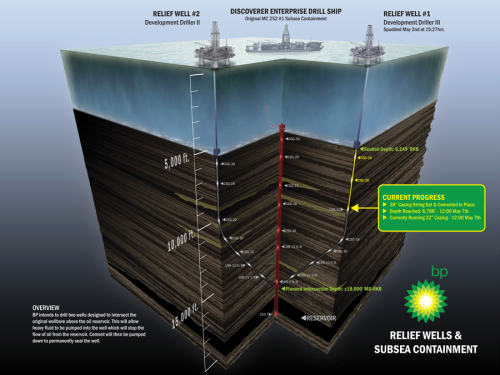BP Oil Relief Plan Infographic
BP has released this infographic, Relief Wells & Subsea Containment, showing how they plan to seal the oil well leak in the Gulf of Mexico, and the current progress at 8,788ft.
British Petroleum intends to drill two wells designed to intersect the original wellbore above the oil reservoir. This will allow heavy fluid to be pumped into the well which will stop the flow of oil from the reservoir. Cement will then be pumped down to permanently seal the well.
BP needs to cement 7 casings into place before the relief well can intersect with the main drill pipe which is pouring approximately 5,000 barrels of oil per day into the ocean. They have completed 3 casings, with 4 remaining. They have reached a drill depth of just below 10,000 feet, with another 8,000 feet remaining. At about 12,000 feet they will begin angling toward the center of the damaged oil pipe.
BP has estimated that the project will require 90 days to complete the first relief well.
Original post on HollywoodBackstage.com, found on VizWorld.com









 Randy
Randy


Reader Comments (11)
Thanks, Randy, for the BP infographic or, to put it another way, propaganda-graphic. Your addition of the text explanation added an important piece of information that BP may have left out of their pretty picture (it was hard for these middle-aged eyes to read the fine print): namely, how long it would take to accomplish the task. Another glaring omission in the "less-than-graphic" graphic: the absence of any spewing oil. The waters appears positively pristine.
So, why does BP need to drill 15,000 feet down to intercept the original pipe? Why not 1,000 feet? Are they trying to keep the well open in the long -term? Is it a hardware issue?
This technique is the back-up safety technique that should have been in place already before the well became operational. It is common practice and obligatory by law over all the European off shore oil fields. If such a back-up safety system exists the well can be closed off within an hour or two so the spill will be very limited and easy to solve without much damage.
The purpose of the two relief wells is to release the pressure in the leaking production well and to pump a solid substance like concrete into and around the leaking well. If the pressure is released the pipe of the production well can be closed with a valve but the leak can also occur around that pipe and most likely it does in this case. Exactly that can have caused the fatal explosion. Otherwise the explosive gases should have been flared off in the regular system. So you have to imagine that along the outside of the well pipe the gases came up, caused an explosion that damaged the whole system of production facilities while killing the crew that was on the watch.
Obviously there was not any expert on deep water oil drilling involved on this job.
You will easily understand that drilling three wells instead of one is very expensive, so, the company has fought against the statuary obligation to this measure of security. It is reported that the Bush43 administration believed that the company should be so wise to voluntarily provide such a security system, because it is urgently needed by deep water drilling. The risks are too high, but in the same time the former administration provided a cap on civil liability for oil companies, down to a maximum of 60 million dollars. Even a 60 billion fine is possibly not enough to cover the cost of environmental restoration.
The costs of the relief wells will be about 30 million dollars and to finish the job the time will expand at least over 90 days.
More about the issue on my blog Pointer's Weekly
How to stop the oil flow, try thinking about this, use the Pungi stick concept, the kind the Vietcong used to stick through soldiers combat boots it will go in but won't come out like hundreds of fish hooks. I know the pressure is great at the bottom of the ocean but using robotics and a sharp spear like tip to cut through the dynamics of the water pressure then feeding it through a tube once it's in it the hole it will anchor itself to the walls, hopefully. God speed and God bless you. Albert Cerecedes.
I think it's funny how clean the water looks in the infographic.
So, some bean counters decided it was better to risk the breach and be liable for 75 million dollars than to take the precautions necessary and spend the required amount to implement them.
Meanwhile, the rest of society has to suffer this catastrophe which is becoming a cataclysm, all too quickly.
Right, we can trust corporations to be stewards of the environment; sure we can.
Planetresource.net has a Eco friendly solution to clean up the tragedy British Petroleum has created, please watch the video animation:
http://www.youtube.com/watch?v=60bdQQQ3iVw and pass this along to as many people as you know.
One person can still make a difference in this world, is that simple interactions have a rippling effect. Each time this gets pass along, the hope in cleaning our planet is passed on.